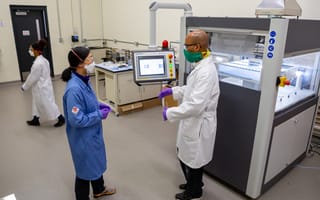
Researchers at the Argonne National Laboratory think they’ve cracked the code for developing the first N95 protective mask that can be cleaned and reused.
Over the past six months, Yuepeng Zhang, a principal materials scientist at Argonne, has led a team of scientists that has used an electrospinning technique to create fibers 1,500 times slimmer than a human hair. The team — working with the California-based Orbis electrical vehicle startup, as well as the Donaldson Company filtration business in Minneapolis — have developed a way to embed new antiviral polymers into the tech, and created an ultra-resilient mask medical professionals can wear to protect themselves from COVID-19.
“The N95 mask, right now it loses effectiveness when sterilized. When we try to disinfect an N95 mask, they lose an important electrostatic charge,” Zhang told Built In. “Usually this is not a problem, but in the pandemic there’s a shortage of [personal protective equipment]. We wanted to find a solution so that we can make a new material that can be sterilized and reused.”
The group decided to focus on refining a process called electrospinning to create an ultra-thin material impervious to COVID-19 — a process researchers had previously tried in creating a new material but had trouble scaling, Zhang said.
Through this technique, scientists use a strong electric field to draw charged threads of a polymer solution out of a thin nozzle. Once the solvent is outside the container, the solution evaporates and the loose polymer threads dry on a clean surface. The team combined antiviral compounds into the solution in a first-of-its-kind measure to increase the resiliency of the mask — normally, N95 masks do not contain antiviral nanoparticles.
While the polymers are drawn out of their casing and dried, a nanotomography machine takes thin, two-dimensional images of the process, which it layers into a model that can be rendered in 3D. This allows Argonne to scale its process, Zhang said, and create a new N95 mask more durable and lighter than its current counterparts. Argonne’s mask complies with the requirements made by the National Institute for Occupational Safety and Health Administration (OSHA), Zhang said.
“To disinfect the mask, we have tried an alcohol soak, bleach solution, bleach-water spray, soapy water, boiling water, all different ways to disinfect the mask, and we did not see a structural change,” Zhang said.
Going forward, Argonne researchers are committing a technical economic analysis to analyze the profit margin potential of the new technology, as well as conducting a safety test of the materials, making sure the mask doesn’t trap too much carbon dioxide when users exhale. Zhang said she hopes to see these reusable N95 masks become widely available within a year, and that Argonne researchers are looking for an industry collaborator that wants to try this technology.
“We expect to transfer our technology to the market in the near future,” Zhang said.






